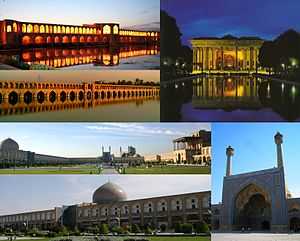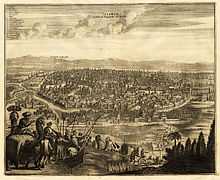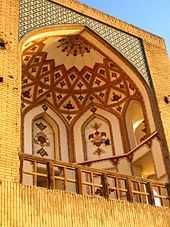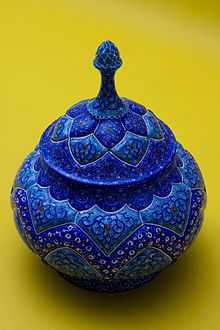Isfahan
| Isfahan (اصفهان) | ||
|---|---|---|
| city | ||
| Ancient names: Spadana, Spahān | ||
 | ||
| ||
| Nickname(s): Nesf-e Jahān (Half of the world) | ||
 | ||
 Isfahan (اصفهان) | ||
| Coordinates: 32°38′N 51°39′E / 32.633°N 51.650°ECoordinates: 32°38′N 51°39′E / 32.633°N 51.650°E | ||
| Country |
| |
| Province | Isfahan | |
| County | Isfahan | |
| District | Central | |
| Government | ||
| • Mayor | Morteza Saqaeian Nejad | |
| Area | ||
| • Total | 280 km2 (110 sq mi) | |
| Elevation | 1,590 m (5,217 ft) | |
| Population (2012) | ||
| • Total | 1,908,968 | |
| • Population Rank in Iran=3rd | 3rd | |
|
Population Data from 2011 Census[1] | ||
| Time zone | IRST (UTC+3:30) | |
| • Summer (DST) | IRDT March 21 – September 20 (UTC+4:30) | |
| Website | www.Isfahan.ir | |
Isfahan (Persian: اصفهان Esfāhān ![]() pronunciation (help·info)), historically also rendered in English as Ispahan, Sepahan or Hispahan, is the capital of Isfahan Province in Iran, located about 340 kilometres (211 miles) south of Tehran. It has a population of 1,583,609 and is Iran's third largest city after Tehran and Mashhad. The Greater Isfahan Region had a population of 3,793,101 in the 2011 Census, the second most populous metropolitan area in Iran after Tehran.[2]
pronunciation (help·info)), historically also rendered in English as Ispahan, Sepahan or Hispahan, is the capital of Isfahan Province in Iran, located about 340 kilometres (211 miles) south of Tehran. It has a population of 1,583,609 and is Iran's third largest city after Tehran and Mashhad. The Greater Isfahan Region had a population of 3,793,101 in the 2011 Census, the second most populous metropolitan area in Iran after Tehran.[2]
The cities of Zarrinshahr, Fooladshahr and Najafabad, Se-deh, Shahin-shahr, Mobarakeh, Falavarjan and Charmahin all constitute the metropolitan city of Isfahan.
Isfahan is located on the main north-south and east-west routes crossing Iran, and was once one of the largest cities in the world. It flourished from 1050 to 1722, particularly in the 16th century under the Safavid dynasty, when it became the capital of Persia for the second time in its history. Even today, the city retains much of its past glory. It is famous for its Islamic architecture, with many beautiful boulevards, covered bridges, palaces, mosques, and minarets. This led to the Persian proverb "Esfahān nesf-e jahān ast" (Isfahan is half of the world).[3]
The Naghsh-e Jahan Square in Isfahan is one of the largest city squares in the world and an outstanding example of Iranian and Islamic architecture. It has been designated by UNESCO as a World Heritage Site. The city also has a wide variety of historic monuments and is known for the paintings and history.
History
Prehistory
The history of Isfahan can be traced back to the Palaeolithic period. In recent discoveries, archaeologists have found artifacts dating back to the Palaeolithic, Mesolithic, Neolithic, Bronze and Iron ages.
Pre-Islamic era

The city emerged gradually over the course of the Elamite civilization (2700 - 1600 BCE) under the name of Aspandana also spelt Ispandana. During the Median dynasty, this commercial entrepôt began to show signs of a more sedentary urbanism, steadily growing into a noteworthy regional center that benefited from the exceptionally fertile soil on the banks of the Zayendehrud River. Once Cyrus the Great (reg. 559 - 529 BCE) unified Persian and Median lands into the Achaemenid Empire (648 - 330 BCE), the religiously and ethnically diverse city of Isfahan became an early example of the king's fabled religious tolerance. The Parthians (250 BCE - 226 CE) continued this tradition after the fall of the Achaemenids, fostering the Hellenistic dimension within Iranian culture and political organization introduced by Alexander's invading armies. Under the Parthians, Arsacid governors administered a large province from Isfahan, and the city's urban development accelerated to accommodate the needs of a capital city. The next empire to rule Persia, the Sassanids (226 - 652 CE), presided over massive changes in their realm, instituting sweeping agricultural reform and reviving Iranian culture and the Zoroastrian religion. The city was then called by the name Spahān in Middle Persian. The city was governed by "Espoohrans" or the members of seven noble Iranian families who had important royal positions, and served as the residence of these noble families as well. Extant foundations of some Sassanid-era bridges in Isfahan suggest that the kings were also fond of ambitious urban planning projects. While Isfahan's political importance declined during the period, many Sassanian princes would study statecraft in the city, and its military role developed rapidly. Its strategic location at the intersection of the ancient roads to Susa and Persepolis made it an ideal candidate to house a standing army, ready to march against Constantinople at any moment. One etymological theory argues that the name 'Aspahan' derives from the Pahlavi for 'place of the army.'[4]

Persia's Capital
In 1598 Shah Abbas the Great moved his capital from Qazvin to the more central and Persian Isfahan, called Ispahān in early New Persian. This new importance ushered in a golden age for the city which lasted until it was sacked by Afghan invaders in 1722. The capital subsequently moved several times until settling in Tehran in 1795. [citation needed]
Modern age
Today Isfahan, the third largest city in Iran, produces fine carpets, textiles, steel, and handicrafts. Isfahan also has nuclear experimental reactors as well as facilities for producing nuclear fuel (UCF). Isfahan has one of the largest steel-producing facilities in the entire region, as well as facilities for producing special alloys. [citation needed]
The city has an international airport and is in the final stages of constructing its first Metro line.
Over 2000 companies are working in the area using Isfahan's economic, cultural, and social potentials. Isfahan contains a major oil refinery and a large airforce base. HESA, Iran's most advanced aircraft manufacturing plant (where the IR.AN-140 aircraft is made), is located nearby.[5]
Isfahan hosted the International Physics Olympiad in 2007.
Geography and climate
The city is located in the lush plain of the Zayandeh River, at the foothills of the Zagros mountain range. No geological obstacles exist within 90 kilometres (56 miles) north of Isfahan, allowing cool northern winds to blow from this direction. Situated at 1,590 metres (5,217 ft) above sea level on the eastern side of the Zagros Mountains, Isfahan has an arid climate (Köppen BWk). Despite its altitude, Isfahan remains very hot during the summer with maxima typically around 36 °C (97 °F). However, with low humidity and moderate temperatures at night, the climate can be very pleasant. During the winter, days are mild while nights can be very cold. Snow has occurred at least once every winter except 1986/1987 and 1989/1990.[6][7]
| Climate data for Isfahan | |||||||||||||
|---|---|---|---|---|---|---|---|---|---|---|---|---|---|
| Month | Jan | Feb | Mar | Apr | May | Jun | Jul | Aug | Sep | Oct | Nov | Dec | Year |
| Record high °C (°F) | 20 (68) |
23 (73) |
27 (81) |
32 (90) |
33.6 (92.5) |
35.2 (95.4) |
37.7 (99.9) |
37.0 (98.6) |
35 (95) |
33.2 (91.8) |
25.5 (77.9) |
21.2 (70.2) |
37.7 (99.9) |
| Average high °C (°F) | 9.2 (48.6) |
12.5 (54.5) |
17.0 (62.6) |
22.7 (72.9) |
28.2 (82.8) |
32.3 (90.1) |
34.7 (94.5) |
33.6 (92.5) |
30.8 (87.4) |
25 (77) |
17 (63) |
11 (52) |
23.42 (74.16) |
| Average low °C (°F) | −2.5 (27.5) |
−0.4 (31.3) |
4.1 (39.4) |
9.3 (48.7) |
13.7 (56.7) |
18.5 (65.3) |
21.0 (69.8) |
19.1 (66.4) |
14.7 (58.5) |
8.9 (48) |
3.2 (37.8) |
−1 (30) |
9.05 (48.29) |
| Record low °C (°F) | −19.4 (−2.9) |
−12.2 (10) |
−6.2 (20.8) |
−4 (25) |
4.5 (40.1) |
10 (50) |
13 (55) |
11 (52) |
5 (41) |
0 (32) |
−8 (18) |
−13 (9) |
−19.4 (−2.9) |
| Precipitation mm (inches) | 29.9 (1.177) |
40.0 (1.575) |
31.7 (1.248) |
28.9 (1.138) |
18.7 (0.736) |
11.2 (0.441) |
6.7 (0.264) |
2.3 (0.091) |
2.1 (0.083) |
13.9 (0.547) |
22.5 (0.886) |
29.7 (1.169) |
237.6 (9.355) |
| Avg. precipitation days (≥ 1.0 mm) | 4.1 | 6.0 | 4.1 | 3.4 | 2.5 | 1.7 | 1.0 | 0.8 | 0.8 | 1.7 | 3.3 | 3.9 | 33.3 |
| % humidity | 60 | 65 | 53 | 60 | 44 | 35 | 25 | 26 | 28 | 38 | 50 | 70 | 46.2 |
| Mean monthly sunshine hours | 203.6 | 216.8 | 243.7 | 250.0 | 308.7 | 348.3 | 349.4 | 339.7 | 311.3 | 281.5 | 224.2 | 197.0 | 3,274.2 |
| Source: Synoptic Stations Statistics | |||||||||||||


Main sights






Mosques
- Agha Nour mosque - 16th century
- Hakim Mosque
- Ilchi mosque
- Jameh Mosque[8]
- Jarchi mosque - 1610
- Lonban mosque
- Maghsoudbeyk mosque - 1601
- Mohammad Jafar Abadei mosque - 1878
- Rahim Khan mosque - 19th century
- Roknolmolk mosque
- Seyyed mosque (Isfahan) - 19th century
- Shah Mosque - 1629
- Sheikh Lotf Allah Mosque - 1618
Palaces and caravanserais
- Ali Qapu (The Royal Palace) – early 17th century
- Talar Ashraf (The Palace of Ashraf) – 1650
- Hasht-Behesht (The Palace of Eight Paradises) – 1669
- Chehel Sotoun (The Palace of Forty Columns) – 1647
- Shah Caravanserai
- Najvan Forest Park
Old schools (madresse)
- Chahar Bagh School - early 17th century
- Harati
- Kassegaran school - 1694
- Madreseye Khajoo
- Nimavar school - 1691
- Sadr school - 19th century
Churches and cathedrals
- Bedkhem Church - 17th century
- St. Georg Church - 17th century
- St. Mary Church - 17th century
- Vank Cathedral – 17th century
Squares and streets
- Naqsh-e Jahan Square also known as "Shah Square" or "Imam Square" – 1602.
- Meydan Kohne (Old Square)
- Chaharbagh Boulevard – 1596.
- Chaharbagh-e-khajou Boulevard
Bazaars
- Shahi Bazaar - 17th century
Bridges
The Zayande River starts in the Zagros Mountains, flows from west to east through the heart of Isfahan, and dries up in the Kavir desert.
The bridges over the river include some of the finest architecture in Isfahan. The oldest bridge is the "Pol-e Shahrestan", which was probably built in the 1100s during the Seljuk period.[citation needed] Further upstream is the "Pol-e Khaju", which was built by Shah Abbas II in 1650. It is 123 metres long with 24 arches, and also serves as a sluice gate.
The next bridge is the "Pol-e Jubi". It was originally built as an aqueduct to supply the palace gardens on the north bank of the river. Further upstream again is the Si-o-Seh Pol or bridge of 33 arches. Built during the rule of Shah Abbas the Great, it linked Isfahan with the Armenian suburb of Jolfa. It is by far the longest bridge in Isfahan at 295 m (967.85 ft).
Other bridges include:
- Pol-e Shahrestan (The Shahrestan bridge)
- Marnan Bridge
- Pol-e Khaju (Khaju Bridge) – 1650.
- Si-o-Seh Pol (The Bridge of 33 Arches) – 1602.
- Pol-e-Joui or Choobi (Joui bridge). - 1665
Minarets
- Ali minaret - 11th century
- Bagh-e-Ghoushkhane minaret - 14th century
- Chehel Dokhtaran minaret - 12 century
- Dardasht minarets - 14th century
- Darozziafe minarets - 14th century
- Menar Jonban - 14th century
- Sarban minaret
Mausoleums and Tombs
- Al-Rashid Mausoleum - 12th century
- Baba Ghassem Mausoleum - 14th century
- Mausoleum of Safavid Princes
- Nizam al-Mulk Tomb - 11th century
- Saeb Mausoleum
- Shahshahan mausoleum - 15th century
- Soltan Bakht Agha Mausoleum - 14th century
Emamzadehs
- Emamzadeh Ahmad
- Emamzadeh Esmaeil, Isfahan
- Emamzadeh Haroun-e-Velayat - 16th century
- Emamzadeh Jafar
- Emamzadeh Shah Zeyd
Tourist Attractions

Isfahan is an important historical center for different groups of tourists in the domestic and international world. The central historical area in Isfahan is called Seeosepol (the name of a famous bridge)[9][10]
Other sites
- Atashgah – a Zoroastrian fire temple.
- Buqe'h-ye Ibn-Sina (Avicenna's Dome) – 12th century.
- New Julfa (The Armenian Quarter). - 1606
- The Bathhouse of Bahāʾ al-dīn al-ʿĀmilī.
- Pigeon Towers[11] – 17th century.
- Takht-e Foulad
Transportation
Airport
Isfahan is served by the Isfahan International Airport which handles domestic flights to Iranian cities and international flights, mostly to regional destinations across Middle East and central Asia including Dubai and Damascus.
Metro and Inter City Public Transportation
Isfahan Metro is under construction and will include 2 lines with 43 km (27 mi) length. The first line of that is planned to be finished by end of 2010 with 21 km (13 mi) length and 20 stations. [citation needed] Until the metro is completed an expanded bus system accompanied by taxis will handle Isfahan intra-urban public transportation.
Rail
Isfahan is connected to three major rail lines: Isfahan-Tehran, Isfahan-Shiraz (recently opened), Isfahan-Yazd and via this recent one to Bandar Abbas and Zahedan.
Road transport
Isfahan's internal highway network is currently under heavy expansion which began during the last decade. Its lengthy construction is due to concerns of possible destruction of valuable historical buildings. Outside the city, Isfahan is connected by modern highways to Tehran which spans a distance of nearly 400 km (248.55 mi) to North and to Shiraz at about 200 km (124.27 mi) to the south. The highways also service satellite cities surrounding the metropolitan area.[12]
Culture
.jpg)
Rug manufacture
Isfahan has long been one of the centers for production of the famous Persian Rug. Weaving in Isfahan flourished in the Safavid era. But when the Afghans invaded Iran, ending the Safavid dynasty, the craft also became stagnant.
Food
- Isfahan is famous for its Beryuni. This dish is made of baked mutton & lungs that are minced and then cooked in a special small pan over open fire with a pinch of cinnamon. Beryuni is generally eaten with a certain type of bread, "nan-e taftton." Although it can also be served with other breads.
See also Biryani. - Fesenjan – a casserole type dish with a sweet and tart sauce containing the two base ingredients, pomegranate molasses and ground walnuts cooked with chicken, duck, lamb or beef and served with rice.
- Gaz – the name given to Persian Nougat using the sap collected from angebin, a plant from the tamarisk family found only on the outskirts of Isfahan. It is mixed with various ingredients including rose water, pistachio and almond kernels and saffron.
- "Khoresht-e mast" (yoghurt stew) is a traditional dish in Isfahan. [citation needed] Unlike other stews despite its name, it is not served as a main dish and with rice; Since it is more of a sweet pudding it is usually served as a side dish or dessert. The dish is made with yogurt, lamb/mutton or chicken, saffron, sugar and orange zest. Iranians either put the orange zest in water for one week or longer or boil them for few minutes so the orange peels become sweet and ready for use. People in Iran make a lot of delicate dishes and jam with fruit rinds. This dish often accompanies celebrations and weddings. [citation needed]
- Pulaki – the name given to a type of Isfahani candy which is formed to thin circles like coins and served with tea or other warm drinks.
Notable people
- Artists
- Jalal al din Taj Esfahani, 1903–, vocalist of Iranian classical music
- Hasan Kasaie, 1928, ney player (ney is a musical instrument used in Iran's classical music)
- Jalil Shahnaz, 1921, Tar player
- Freydoon Rassouli, artist and founder of Fusionart movement
- Master Ahmad Archang, artist and designer of Isfahan rug patterns
- Alireza Eftekhari, 1956–, singer
- Mohammad Esfahani, popular music
- Nasrollah Moein, 1951–, popular and classical music
- Hoshmand Aghili, 1945–, popular and classical music
- Hassan Shamaizadeh, music composer and Singer
- Leila Forouhar, Iranian pop singer
- Actors and movie directors
- Reza Arhamsadr, 1923–2008, famous father of Persian comic cinema and theater, actor
- Asghar Farhadi, 1972–, Oscar-winning director
- Nosratolah Vahdat, 1925, actor
- Mohamad Ali Keshvarz, 1930, actor
- Jahangir Forouhar, 1916–1997, actor and father of Leila Forouhar (Iranian singer)
- Bahman Farmanara, 1942–, director
- Kiumars Poorahmad, 1949–, director
- Rasul Sadr Ameli, 1953–, director
- Homayoun Asaadian, director
- Soraya Esfandiary-Bakhtiari, 1956–2001, former princess of Iran and actress
- Homayoun Ershadi, 1947–, Hollywood actor and architect
- Painters
- Bogdan Saltanov, 1630s–1703, Russian icon painter of Isfahanian Armenian origin
- Sumbat Der Kiureghian, 1913–1999 (سمبات دِر كيوُرغيان), an Isfahanian Armenian painter
- Hossein Mosaverolmolki, 1889–1969, (حسين مصورالملكي), painter and miniaturist
- Yervand Nahapetian, 1917–, (يرواند نهاپطيان), Isfahanian Armenian painter
- Freydoon Rassouli, American painter born and raised in Isfahan
- Ostad Javad Rostamshirazi, 1919–, Isfahanian painter
- Mahmoud Farshchian, 1930–, miniaturist
- Political figures
- Ayatollah Mohammad Beheshti, 1928–1981, cleric, Chairman of the Council of Revolution of Iran
- Mohammad-Ali Foroughi, a politician and Prime Minister of Iran in World war II era
- Shapour Bakhtiar, ex-Prime Minister of Iran
- Hossein Fatemi, 1919–1954, PhD, politician (foreign minister in Mohamed Mossadegh Cabinet)
- Ahmad Amir-Ahmadi, 1906–1965, military leader and cabinet minister
- Hossein Kharrazi, chief of army in the Iran–Iraq war
- Mohsen Nourbakhsh, 1948–2003, economist, Governor of the Central Bank of Iran
- Nusrat Bhutto, Chairman of Pakistan Peoples Party from 1979–1983, wife of Zulfikar Ali Bhutto, and mother of Benazir Bhutto.
- Dariush Forouhar, (August 1928 - November 1998) was a founder and leader of the Hezb-e Mellat-e Iran (Nation of Iran Party)
- Religious figures
- Salman the Persian
- Allamah al-Majlisi, 1616–1698, Safavid cleric, Sheikh ul-Islam in Isfahan
- Ayatollah Rahim Arbab chiarmahini, 1847–?, cleric, Ayatollah-al-ozma rank
- Ayatollah Mohammad Beheshti, 1928–1981, cleric, Chairman of the Council of Revolution of Iran
- Ayatollah Ashrafi Esfahani, 1902–1982, cleric, Friday Prayer of Kermanshah
- Sportspeople
- Mahmoud Yavari, محمود یاوری,–1939, footballer, former player for Shahine Esfahan and Iranian National Team from 1958 to 1970, former coach of Iranian National Team
- Abdolali Changiz, football star of Esteghlal FC in 1970s
- Mansour Ebrahimzadeh, former player for Sepahan FC in 1970s and 1980s, former head coach of Zobahan
- Rasoul Korbekandi, goalkeeper of the Iranian National Team
- Moharram Navidkia, captain of the Sepahan
- Ehsan Hajsafi, player for the Sepahan
- Arsalan Kazemi, forward for the Oregon Ducks men's basketball team and the Iran national basketball team.
- Mohammad Talaei, world champion wrestler
- Writers and poets
- Hamid Mosadegh, 1939–1998, poet and lawyer
- Hatef Esfehani, Persian Moral poet in Afsharye Era
- Helen Ouliaei Nia, literary critic
- Houshang Golshiri, 1938–2000, writer and editor
- Kamal ed-Din Esmail
- Mirza Abbas Khan Sheida, 1880–1949, poet and publisher
- Mohammad-Ali Jamālzādeh Esfahani, 1892–1997, author
- Saib Tabrizi
- Others
- Nasser David Khalili, 1945–, property developer, art collector, and philanthropist
- Arthur Pope, 1881–1969, American archaeologist, buried near Khaju Bridge
Education

Aside from the seminaries and religious schools, the major universities of the Esfahan metropolitan area are:
- Universities
- High schools
- Harati High School
- Adab High School
- Imam Mohammad Bagher Education Complex
- Mahboobeh Danesh(Navaie)
- Shahid Ejei High School
- Farzanegan e Amin High School
- Imam Sadegh Education Complex
There are also more than 50 Technical and Vocational Training Centers under the administration of Esfahan TVTO which provide non-formal training programs freely throughout the province.[14]
Sports
Isfahan is the host of many national and international sport events therefore enjoying sport facilities such as Naghsh-e-Jahan Stadium with 50,000 capacity which second phase is under development to increase capacity to 75,000 spectators. Isfahan has an important derby called as Naqsh e jahan derby. This competition is one of the most popular annual football events in Iran between Sepahan Isfahan and Zob Ahan Isfahan.
Isfahan has two association football clubs that have been title contenders in Iran's Premier Football League. These are:
Twin towns – Sister cities

Isfahan is twinned with:
See also
References
- Urban Planning of Isfahan in the Seventeenth Century – Abouei, Reza, University of Sheffield, School of Architecture, 2005
- Notes
- ↑ Census (from the Statistical Center of Iran, in Persian.)
- ↑ 2006 Census Results and Mashhad(Statistical Center of Iran, Excel file, in Persian.)
- ↑ "Isfahan Is Half The World", Saudi Aramco World, Volume 13, Nr. 1, January 1962
- ↑ http://archnet.org/library/places/one-place.jsp?place_id=1752&order_by=title&showdescription=1
- ↑ Hesaco.com (from the HESA official company website)
- ↑ "Snowy days for Esfahan". Irimo.ir. Retrieved 2012-04-23.
- ↑ assari, ali; T.M. Mahesh (August 2011). "Demographic comparative in heritage texture of Isfahan city". Journal of Geography and Regional Planning. ISSN 2070-1845 ©2011 Academic Journals 4 (8): 463–470. Retrieved 6 January 2013.
- ↑ "Isfahan Jame(Congregative) mosque - BackPack". Fz-az.fotopages.com. Retrieved 2009-07-26.
- ↑ "Seifolddini-Faranak; M. S. Fard; Hosseini Ali" (PDF). thescipub.com.
- ↑ Assari, Ali; T.M. Mahesh (january 2012). "Conservation of historic urban core in traditional Islamic culture: case study of Isfahan city". Indian Journal of Science and Technology 5 (1): 1970–1976. Retrieved 7 January 2013.
- ↑ "Castles of the Fields". Saudi Aramco World. Retrieved 2012-09-11.
- ↑ Assari, Ali; Erfan Assari (2012). "Urban spirit and heritage conservation problems: case study Isfahan city in Iran". Journal of American Science 8 (1): 203–209. Retrieved 7 January 2013.
- ↑ "iaumajlesi.ac.ir". iaumajlesi.ac.ir. Retrieved 2012-09-11.
- ↑ "Isfahan Technical and Vocational Training Organization". Web.archive.org. 2007-10-08. Archived from the original on 2007-10-08. Retrieved 2012-04-23.
- ↑ "Isfahan, Beirut named sister cities". MNA. Retrieved 2007-05-02.
- ↑ "Barcelona internacional – Ciutats agermanades" (in Catalan). 2006–2009 Ajuntament de Barcelona. Retrieved 2009-07-13.
- ↑ "Sister Cities of Istanbul". Retrieved 2009-07-01.
- ↑ Erdem, Selim Efe (2009-07-01). "İstanbul'a 49 kardeş" (in Turkish). Radikal. Retrieved 2009-07-26. "49 sister cities in 2003"
- ↑ "Sisterhoods". Isfahan Islamic Council. 2005. Archived from the original on 2007-10-12. Retrieved 2007-12-04.
- ↑ "Saint Petersburg in figures – International and Interregional Ties". Saint Petersburg City Government. Retrieved 2008-07-14.
- ↑ "Yerevan - Twin Towns & Sister Cities". Yerevan Municipality Official Website. © 2005—2013 www.yerevan.am. Retrieved 2013-11-04.
- ↑ "ԵՐԵՎԱՆԻ ՔԱՂԱՔԱՊԵՏԱՐԱՆՊԱՇՏՈՆԱԿԱՆ ԿԱՅՔ" [Yerevan expanding its international relations] (in Armenian). . Archived from the original on 2013-05-12. Retrieved 2013-08-05.
External links
| Wikimedia Commons has media related to Isfahan. |
![]() Isfahan travel guide from Wikivoyage
Isfahan travel guide from Wikivoyage
- Isfahan official website
- Isfahan Metro
- 360 degrees panorama gallery of Isfahan
- Isfahan Geometry on a Human Scale A Documentary film directed by Manouchehr Tayyab (30 min)
| Preceded by Rey |
Capital of Seljuq Empire (Persia) 1051–1118 |
Succeeded by Hamadan (Western capital) Merv (Eastern capital) |
| Preceded by Qazvin |
Capital of Iran (Persia) 1598-1736 |
Succeeded by Mashhad |
| Preceded by Qazvin |
Capital of Safavid dynasty 1598-1722 |
Succeeded by - |
| ||||||||||||||||||||||||||||||||||||||||||||||||||||||||||||||||||||||||||||||||||||||
| |||||||||||||||||||||||||||



